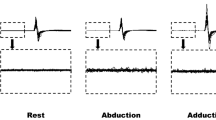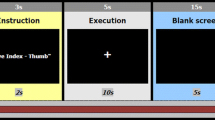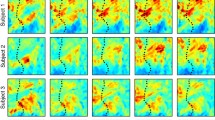Summary
The cerebral potentials associated with voluntary, self-paced rapid flexions of (1) right fingers, (2) left fingers, (3) right toes, and (4) left toes were compared in the same experiment using 32 right- and left-handed subjects. The Bereitschaftspotential (BP) or readiness potential was, in the first half of the foreperiod, bilaterally symmetrical for both finger and toe movements of either side. In the later foreperiod there were differences: Finger movements showed two maxima, an early one at Cz and a late one, which was lateralized toward the contralateral precentral region. With toe movements, the maximum BP amplitude was always at Cz and not lateralized and was twice as large as with finger movements. The data are compatible with the view that two principal sources of different spatial and temporal characteristics are active in the foreperiod of a voluntary movement. The early generator is probably the supplementary motor area (SMA) on the mesial surface of the hemispheres; the later is the primary motor cortex (MI) which is lateralized for finger but not for toe movements. In lateral leads, rather remote from the mesial source, the BP for toe movements showed a small but significant ipsilateral preponderance, which is obviously due to the fact that dipole sources located on the mesial surface of the hemispheres point to the opposite direction as compared to those on the convexity. Topographic maps of the pre-motion possitivity (PMP) and the motorpotential (MP) reveal the locations of the respective MI generators for toe and finger movements. The MP for toe movements clearly exhibited a similar ipsilateral side preponderance as the BP and hence caused the PMP topography for toe movements to be the reverse of that for finger movements. The potentials after the onset of movement show a longer negativity in Cz and FCz for toe than for finger movements.
Similar content being viewed by others
References
Barrett G, Blumhardt L, Halliday AM, Halliday E, Kriss A (1976) A paradox in the lateralization of the visual response. Nature 261: 253–255
Brinkman C, Porter R (1979) Supplementary motor area in the monkey: Activity of the neurons during performance of a learnt motor test. J Neurophysiol 42: 681–709
Brunia CHM (1980) What is wrong with legs in motor preparation? In: Kornhuber HH, Deecke L (eds) Motivation, motor and sensory processes of the brain. Prog Brain Res 54: 232–236
Brunia CHM, van den Bosch WEJ (1983) The influence of response side on the readiness potential prior to foot and finger movements. In: Karrer R, Cohen J, Tueting P (eds) Brain and information: Event-related potentials. Ann NY Acad Sci (in press)
Brunia CHM, Vingerhoets AJJM (1981) Opposite hemisphere differences in movement-related potentials preceding foot and finger flexions. Biol Psychol 13: 261–269
Cruse R, Klem G, Lesser RP, Lueders H (1982) Paradoxical lateralization of cortical potentials evoked by stimulation of the posterior tibial nerve. Arch Neurol 39: 222–225
Deecke L, Boschert J, Brickett P, Weinberg H (1983) Magnetic fields of the human brain (Bereitschaftsmagnetfeld) associated with voluntary foot or toe movements. Exp Brain Res 52: 81–86
Deecke L, Eisinger H, Kornhuber HH (1980) Comparison of Bereitschaftspotential, pre-motion positivity and motor potential preceding voluntary flexion and extension movements in man. In: Kornhuber HH, Deecke L (eds) Motivation, motor and sensory processes of the brain. Prog Brain Res 54: 171–176
Deecke L, Grözinger B, Kornhuber HH (1976) Voluntary finger movement in man: Cerebral potentials and theory. Biol Cybern 23: 99–119
Deecke L, Heise B, Kornhuber HH, Lang M, Lang W (1983b) Brain potentials associated with voluntary manual tracking: Bereitschaftspotential, conditioned pre-motion positivity (cPMP), directed attention potential (DAP), and relaxation potential (RXP); anticipatory activity of the limbic and frontal cortex. In: Karrer R, Cohen J, Tueting P (eds) Brain and information: Event-related potentials. Ann NY Acad Sci (in press)
Deecke L, Kornhuber HH (1978) An electrical sign of participation of the mesial supplementary motor cortex in human voluntary movement. Brain Res 159: 473–476
Eccles JC (1982) The initiation of voluntary movements by the supplementary motor area. Arch Psychiat Nervenkr 231: 423–441
Kornhuber HH, Deecke L (1965) Hirnpotentialänderungen bei Willkürbewegungen und passiven Bewegungen des Menschen: Bereitschaftspotential und reafferente Potentiale. Pflügers Arch 284: 1–17
Kristeva R, Keller E, Deecke L, Kornhuber HH (1979) Cerebral potentials preceding unilateral and bilateral simultaneous finger movements. Electroencephalogr Clin Neurophysiol 47: 229–238
Lassen NA, Ingvar DH, Skinhøj E (1978) Brain function and blood flow. Sci Am 239: 62–71
Oldfield RC (1971) The assessment and analysis of handedness. The Edinburgh Inventory. Neuropsychologia 9: 97–113
Shibasaki H, Barrett G, Halliday E, Halliday AM (1981) Cortical potentials associated with voluntary foot movement in man. Electroencephalogr Clin Neurophysiol 52: 507–516
Vaughan HG, Costa LD, Ritter W (1968) Topography of the human motor potential. Electroencephalogr Clin Neurophysiol 25: 1–10
Author information
Authors and Affiliations
Additional information
Dedicated to Professor Richard Jung on the occasion of his 70th birthday
Supported by the Deutsche Forschungsgemeinschaft, De 302/3-1
Rights and permissions
About this article
Cite this article
Boschert, J., Hink, R.F. & Deecke, L. Finger movement versus toe movement-related potentials: Further evidence for supplementary motor area (SMA) participation prior to voluntary action. Exp Brain Res 52, 73–80 (1983). https://doi.org/10.1007/BF00237151
Received:
Revised:
Issue Date:
DOI: https://doi.org/10.1007/BF00237151




